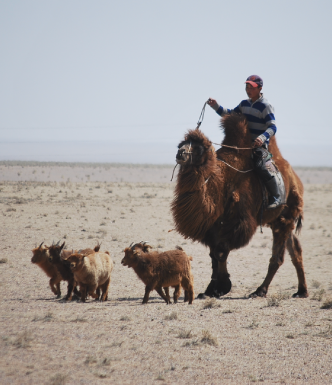
Take action for camelids

-
Develop tailored camelid development policies
Develop tailored camelid development policies that recognize the role of camelids as a way to fight hunger, build resilience to climate change, and conserving biodiversity and ecosystems. -
Develop policies that support livelihoods
Take actions to support the livelihoods of communities that depend on camelids by developing and implementing policies to increase their access to markets, resources and services, emphasizing the role of youth and women. -
Develop public awareness campaigns
Build public awareness about the importance of camelids by developing and promoting awareness campaigns -
Protect traditional knowledge and heritage
Protect the traditional knowledge, practices and heritage of Indigenous Peoples and local communities that depend on camelids. -
Promote camelid products
Promote camelid products to improve the livelihoods of vulnerable rural populations, create decent jobs and greater equality. -
Engage youth
Actively engage young people to work in the camelid sector. -
Empower camelid producers
Strengthen the organizational and leadership capacities of camelid producers.

-
Keep informed
Learn more about and better understand camelids and their cultural, social and economic importance, particularly for Indigenous Peoples and local communities. Recognize the role of camelids in conserving biodiversity and cultural heritage. -
Purchase camelid products
Purchase more goods produced from camelids, including edible goods and clothes made of natural renewable fibres. -
Spread the word!
Spread the word about the #YearofCamelids on social media and in your communities throughout 2024 and beyond. -
Choose green, choose camelids
Value camelid products, taking into account their contribution to the sustainable management of livelihoods and ecosystems.

-
Build your skills base
Learn about good practices for producing and processing camelid products to ensure the highest quality, and increase income derived from production and processing, and from the marketing of fibre, meat and hides. -
Learn about sustainable practices
Strengthen and promote the conservation and sustainable management of camelids and natural pastures, including biodiversity, considering the reduced feed and water availability due to the deterioration of natural resources and climate change. -
Form producer organizations
Join forces and form producer organizations to have more of a say in government policies; gain better access to markets, resources and services; and add value to your products.

-
Connect producers to markets
Provide producers with practical support, training and ways of adding value to their products, connecting them to traditional and alternative markets. -
Promote camelids
Share information related to camelids with a broad range of audiences, including through the organization of events and campaigns. -
Form camelid action groups
Form networks and action groups to promote the availability, accessibility and affordability of camelid products. -
Leave no one behind
Strengthen negotiating capacities of producers and sensitize value chain actors in a win-win culture that leaves no one behind, and considers the rights, culture and traditional knowledge of Indigenous Peoples and local communities. -
Support indigenous and local practices
Support the review and documentation of indigenous and local practices for camel breeding, husbandry, disease control, and marketing, among others. -
Drive climate adaptation
Develop the capacities of camelid producers in climate change adaptation.

-
Innovate the camelid sector
Dedicate resources to researching camelids, the nutritional benefits, properties and characteristics of camelid products, as well as to practices and innovations that can make camelid production more sustainable. -
Gather and disseminate evidence
Gather and disseminate evidence related to camelids that can inform relevant management and development approaches, including for climate change adaptation and improved contributions to nutrition, food security and environmental sustainability in a participatory manner, taking into account traditional knowledge.

-
Integrate camelid production in development projects
Develop and implement programmes and projects that include camelid-related activities to improve food security and nutrition, eradicate poverty and enhance the sustainable use of natural resources. -
Support fair and equitable value chains
Support the development of fair and equitable value chains that enable camelid producers to benefit from markets by addressing limitations in processing and marketing, including a lack of access to financial services.
EIN Presswire does not exercise editorial control over third-party content provided, uploaded, published, or distributed by users of EIN Presswire. We are a distributor, not a publisher, of 3rd party content. Such content may contain the views, opinions, statements, offers, and other material of the respective users, suppliers, participants, or authors.

